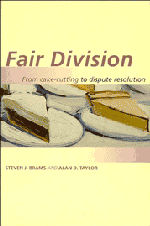Book contents
- Frontmatter
- Contents
- List of figures
- List of tables
- Acknowledgments
- Introduction
- 1 Proportionality for n = 2
- 2 Proportionality for n > 2: the divisible case
- 3 Proportionality for n > 2: the indivisible case
- 4 Envy-freeness and equitability for n = 2
- 5 Applications of the point-allocation procedures
- 6 Envy-free procedures for n = 3 and n = 4
- 7 Envy-free procedures for arbitrary n
- 8 Divide-the-dollar
- 9 Fair division by auctions
- 10 Fair division by elections
- 11 Conclusions
- Glossary
- Bibliography
- Index
2 - Proportionality for n > 2: the divisible case
Published online by Cambridge University Press: 05 July 2011
- Frontmatter
- Contents
- List of figures
- List of tables
- Acknowledgments
- Introduction
- 1 Proportionality for n = 2
- 2 Proportionality for n > 2: the divisible case
- 3 Proportionality for n > 2: the indivisible case
- 4 Envy-freeness and equitability for n = 2
- 5 Applications of the point-allocation procedures
- 6 Envy-free procedures for n = 3 and n = 4
- 7 Envy-free procedures for arbitrary n
- 8 Divide-the-dollar
- 9 Fair division by auctions
- 10 Fair division by elections
- 11 Conclusions
- Glossary
- Bibliography
- Index
Summary
Introduction
Although a player like the president may propose legislation, almost invariably provisions are added to and subtracted from such a proposal, votes are taken, new changes made, and so on, as a bill wends its way through the legislative process. Likewise, the implementation of this legislation, once enacted, is also subject to significant modification through executive orders, court cases, citizen response, and the like.
Both divide-and-choose (section 1.2) and filter-and-choose (section 1.3) are strictly applicable only to two players. Although we suggested in section 1.4 that filter-and-choose is, effectively, played again and again in the legislative process, this two-person procedure provides an incomplete model if there are different players at each stage. Consequently, we ask whether there is an extension of divide-and-choose to more than two players.
The answer to this question, discovered by Hugo Steinhaus but discussed for the first time in Knaster (1946), extends divide-and-choose to three people. This result and others we shall describe in this chapter initiated the modern era of research on fair division, which focused on cake cutting but involved procedures for allocating indivisible goods as well (see chapter 3).
Hugo Steinhaus was a mathematician who, together with his colleagues, Bronislaw Knaster and Stefan Banach, began their research on fair-division procedures in Poland during World War II (Steinhaus, 1948).
- Type
- Chapter
- Information
- Fair DivisionFrom Cake-Cutting to Dispute Resolution, pp. 30 - 50Publisher: Cambridge University PressPrint publication year: 1996



